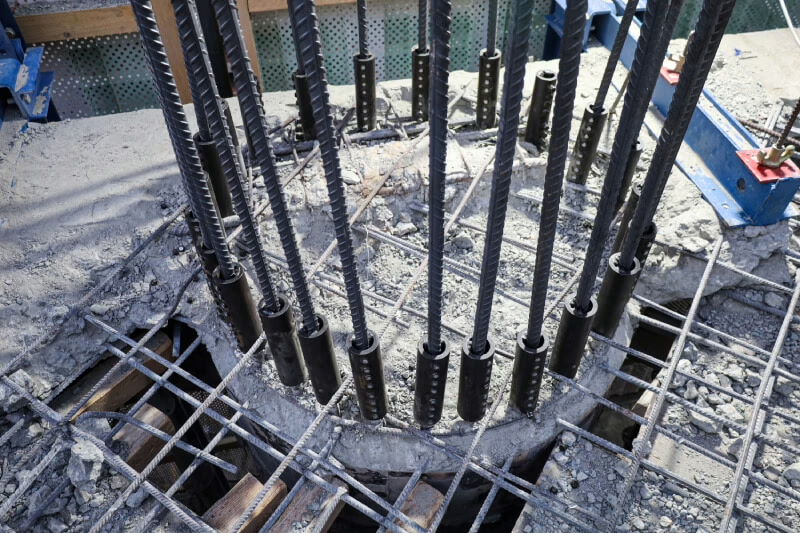Types of pile foundations and their construction methods
Posted 29 Oct 2025
You’ll know that some of the most important things in life are the things you can’t see, and this is never truer than when it comes to talking about foundations. Structural stability begins deep below the surface, out of sight but where the component parts play a critical role in the overall structural performance. Conventional shallow foundations just don’t cut it if the ground is weak, inconsistent or highly compact. So, in conditions like these, pile foundations are a dependable, deep-foundation solution.
Understanding pile foundations
Piles are long, slender structural elements, often cylindrical, that are driven, drilled or cast into the ground until they reach deeper, more suitable ground conditions so that they can take the weight and load of a range of heavy structure types, such as buildings, high-rise towers and large-scale industrial warehouses. Running piling systems deep in the ground until they reach more suitable ground conditions avoids potential problems with unsuitable or more challenging surface materials, minimising settlement issues, uplift or lateral forces, enhancing the overall integrity of the structure.
So why do we love pile foundations? Because they are indispensable in sites where shallow foundations would not be up to the job, like reclaimed land or waterlogged areas for example. As a complex and costly foundation there’s quite a wide choice of foundation piling methods depending on the load capacity, budget, construction time and site impact.
The main types of pile foundations
Foundation piles are commonly classified by material, load transfer mechanism or installation method and it’s these distinctions that help a structural engineer know which pile to use and select the right piling construction approach, tailored to the specific needs of the construction project.
- Concrete piles: These can be either ready-made as precast or cast-in-situ, which means they are bored onsite and concrete poured. Concrete pile foundations are exceptionally strong and offer superb quality control while bored piles better suit ground where there is a variety of soil layers, often found in built-up urban areas.
- Steel piles: These can be used for deep pile foundations for lighter-load applications, such as bridges and marine works.
- End-bearing piles: Transfer loads directly onto a strong stratum such as dense sand or bedrock.
- Friction piles: Depend on skin friction between the pile shaft and surrounding soil.
- Combined piles: Use both end bearing and friction resistance for maximum stability.
Piling construction methods
Who knew there were so many kinds of piles and piling construction methods? Just like choosing the right pile material and load transfer option, the selection of piling construction method is determined by the soil conditions, constraints and overall project requirements, found on site:
- Driven piles: Heavy weight machinery hammers or vibrates pre-formed piles into the ground. Piles can be made from steel, timber or precast concrete. The beauty of this pile foundation construction method is that it provides reliable, consistent and immediate load-bearing capacity. A downside is the extreme noise and vibration the process creates making it unsuitable in some highly populated areas.
- Bored (Cast-in-Situ) piles:
When the level of noise needs to be managed due to working in a restricted or noise-sensitive location this is the most suitable piling method. Compared to the traditional driven piling technique, noise and vibration is kept to a minimum which ultimately means less disruption.
For this method, rather than a pile being hammered down until it reaches a suitable soil condition, a hole is carefully drilled to the suitable depth and then filled with reinforced concrete which once set forms a strong and stable foundation element. An added advantage with bored piles is that you have exact control over the depth and diameter of the pile foundation. Such precision means that performance can be optimised to suit a variety of soil conditions. - Rotary bored piles
High-load projects demand exceptionally high-strength piles, and rotary bored piles are ideal for more major infrastructure projects of a bigger scale. - Continuous flight auger (CFA) piles:
Another alternative for achieving a less disruptive and noisy construction process, CFA piles are a quiet, vibration-free option for urban sites and are widely used in modern piling construction work. - Screw (Helical) piles
If the project is for a light structure, commercial or residential, then screw piles are a good option, being quick to install with minimal vibration and even better, deliver immediate load-bearing capacity. As the name suggests, piles are installed by screwing steel shafts with helical plates into the ground until they reach suitable soil.
Choosing the right type of pile foundation
There are four main factors that influence the pile selection when evaluating the optimum type of pile foundation:
- Soil conditions: Load bearing capacity, compressibility and groundwater level.
- Structural loads: Magnitude and direction of applied forces.
- Site environment: Access limitations, vibration control and spoil disposal.
- Cost and sustainability: The holy grail of balancing economic efficiency with environmental responsibility.
The first and most crucial step in any pile foundation detail design is always a thorough geotechnical investigation. This provides a structural engineer with super detailed, essential information about the soil properties, subsurface conditions and load-bearing capacity, all of which influence the stability, safety and long-term efficiency of the structure.
Pile foundations are the backbone of long-lasting construction
Pile foundations are quite literally groundbreaking because they enable construction to happen in places that might otherwise be overlooked for building opportunities. With an array of choices, understanding the various types of piling and construction methods means engineers can design efficient, economical and environmentally responsible solutions to suit the unique needs of every project. Innovative technologies and continuous advances in materials and installation equipment mean that pile foundations are becoming even more low impact, reducing vibration and noise to more acceptable levels, securing them a vital role in the future of resilient and sustainable construction the world over.




